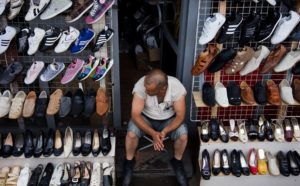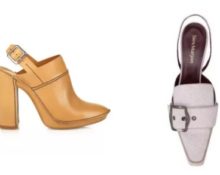One of the most discussed topics is chipization of shoes. Some people expect big troubles from the innovation, others hope to get significant benefits from the innovation, and still others simply don’t know how to find the codes and where to print labels for them. Let's try to figure out what the law on mandatory microchipping of shoes has in store for us.
What kind of procedure is shoe microchipping?
 This is a new type of marking. It differs from the previous one in the coverage of information and the level of security. The code will contain absolutely all the data for a specific pair: logistics issues, information about certification, consumer characteristics, details of operators and participants in the scheme. Due to the completeness of the description, doubts about the originality of a particular product will be dispelled and the possibility of selling counterfeits will disappear altogether. Copies and products whose manufacturers work according to “gray schemes” simply will not be able to wedge themselves into the delivery process to the store counter.
This is a new type of marking. It differs from the previous one in the coverage of information and the level of security. The code will contain absolutely all the data for a specific pair: logistics issues, information about certification, consumer characteristics, details of operators and participants in the scheme. Due to the completeness of the description, doubts about the originality of a particular product will be dispelled and the possibility of selling counterfeits will disappear altogether. Copies and products whose manufacturers work according to “gray schemes” simply will not be able to wedge themselves into the delivery process to the store counter.
Himself the chip looks like a 2D barcode that will need to be applied to the outside of the box. The exact location of the attachment has not yet been fixed in the regulatory documents, since the government plans to give market participants the right to choose where to place the marker.
Mandatory microchipping regulations
Before you go shopping for chipping equipment, check out the list of products that should and can be labeled in this way. If a specific product is not listed, then you have until February 2020. Spend the remaining days trying to sell the pair. This will have to be done, because from the date indicated, sales and other actions with unchipped products will begin to be punishable by law.
Important! Not long ago it was decided to extend the experimental period of the new labeling system. Previously, it was supposed to end on June 30.
Pros and cons of the procedure
 It's obvious that counterfeits will disappear from shelves, since the chips will contain the entire logistics path, including the certification stage. Due to this, buyers will begin to take less risks and less often encounter so-called disposable products, which very quickly lose their appearance and tear (products that have not been certified). We will not offer harmful shoes, in the production of which substances and materials hazardous to humans were used to reduce costs.
It's obvious that counterfeits will disappear from shelves, since the chips will contain the entire logistics path, including the certification stage. Due to this, buyers will begin to take less risks and less often encounter so-called disposable products, which very quickly lose their appearance and tear (products that have not been certified). We will not offer harmful shoes, in the production of which substances and materials hazardous to humans were used to reduce costs.
At the same time, you need to be realistic and understand that the market for cheap shoes is primarily represented by products that are stamped in illegal artisanal conditions, as well as Chinese products. Both shoes will become “persona non grata” after the introduction of microchipping. In other words, chipization will help reduce the market share of goods available to low-income people. They will have to get out of the current situation, and there will clearly be people who want to ease the process of breaking out of the economic impasse. Therefore, most likely, counterfeit products will disappear only from the shelves, but not from our lives. It, as in the Soviet years, can be purchased from a special category of people under the counter.
Important! One of the official “advantages” of chipization is the elimination from the shoe market of those who work under gray schemes. However, there is a possibility that the innovation, on the contrary, will exacerbate the corruption component of the process.
 Another “plus” will be appreciated by those who work under franchises of large shoe manufacturers. The innovation promises them an increase in clientele, on the one hand, and assistance in equipping them with the necessary equipment, on the other. Franchisees, unlike small entrepreneurs, have the right to rely on their franchisor, who, under the terms of the contract, often undertakes to provide his “younger brother” with everything necessary for conducting successful trading activities, including equipment.
Another “plus” will be appreciated by those who work under franchises of large shoe manufacturers. The innovation promises them an increase in clientele, on the one hand, and assistance in equipping them with the necessary equipment, on the other. Franchisees, unlike small entrepreneurs, have the right to rely on their franchisor, who, under the terms of the contract, often undertakes to provide his “younger brother” with everything necessary for conducting successful trading activities, including equipment.
There are also temporary advantages to what is happening. One of them - possibility of receiving free codes. While chipping is operating as part of a pilot project, no money is charged for generating a marker. After testing the system, you will most likely have to pay for each code separately. It is not yet known how much, only an approximate amount is given: 50 kopecks + VAT for 1 pair.
Buyers who have always preferred expensive or even luxury shoes will finally be able to breathe freely after the introduction of chipization. From now on they will be confident that they have purchased original products and are fully protected by the state from the actions of unscrupulous retailers. Moreover, you don’t have to do anything special to calm down. The information presented on the chip will also be read by smartphones. Naturally, subject to an Internet connection.
“Pitfalls” - do they exist?
 The situation with chipping has already acquired myths. One of them is actively promoted by large domestic manufacturers, who saw in what was happening an opportunity to expand the audience and subsequent sales growth. They insist that the specific smell in the stores of their competitors selling budget products is caused by the low quality of the raw materials from which the goods are made.
The situation with chipping has already acquired myths. One of them is actively promoted by large domestic manufacturers, who saw in what was happening an opportunity to expand the audience and subsequent sales growth. They insist that the specific smell in the stores of their competitors selling budget products is caused by the low quality of the raw materials from which the goods are made.
In fact the smell of things made from leather is considered normal. Exactly the same as for shoe care and cleaning products. It turns out that in order to stop the smell of leather in shoe departments, it is not necessary to introduce chips, but to remove everything leather from these stores. True, in this case the store will cease to be a shoe store.
The second pitfall again concerns hidden benefits for domestic producers. Large factories that sell products through their own stores, as well as their franchisees, can easily install reading devices in their retail outlets (and some will only need to reconfigure existing equipment). Well, a seller at a city market or a novice entrepreneur who only opened a small shoe department six months ago will face serious difficulties when equipping.
Purchasing new commercial equipment is an expensive pleasure in itself, and chipping specifically, like any innovation, will initially require special control and staff training. As a result, some small sellers will disappear from the market, giving up their place and clientele to domestic mastodons in the shoe business.
Important! Chipization, according to preliminary data, will require an expansion of staff.
The third nuance is the obligatory presence of the Internet. It will not be possible to carry out the reading procedure without connecting to the network.. And here again, as in the previous paragraph, doubts arise regarding the survival of market stalls and small shoe departments. Especially those who have already purchased large quantities of unchipped shoes, because the question of what to do with such goods after the introduction of the law on chips remains open to this day. It has already been brought up for discussion several times, but as a result they could only agree that it is profitable to chip previously purchased products now, while the experimental period of the new type of marking is in effect.
Important! Some people who actively promote the innovation to the masses and are absolutely indifferent to the fate of small retail outlets insist that all unchipped shoes should be confiscated and disposed of. Without any compensation to the seller. Perhaps their proposal will be accepted and allowed to be implemented.
The innovation raises a lot of questions; even the developers admit that the system is still quite crude. The only thing we can say for sure is that very soon shoes will disappear from rural and village shops. From now on, villagers will have to go to the city for boots or slates, because it will simply not be profitable for their usual sellers to equip their work area with expensive equipment. It’s not profitable, if only because their potential clientele is limited, at best, to a few hundred people – that’s exactly how many residents there are in the average Russian village.
How will microchipping affect the cost of shoes?
 Chipping is not a type of indirect tax and not a source of replenishment of the treasury. Chips have a completely different function, and therefore the economic scheme that applies in the case of excise taxes does not work with them. And if excise taxes are actually paid by the consumer, then they will not be calculated for chipization. More precisely, they will not, according to the official version, according to which all costs associated with implementation fall on the shoulders of manufacturers. Indirectly, buyers will still feel the pressure of innovation.
Chipping is not a type of indirect tax and not a source of replenishment of the treasury. Chips have a completely different function, and therefore the economic scheme that applies in the case of excise taxes does not work with them. And if excise taxes are actually paid by the consumer, then they will not be calculated for chipization. More precisely, they will not, according to the official version, according to which all costs associated with implementation fall on the shoulders of manufacturers. Indirectly, buyers will still feel the pressure of innovation.
Indirect - because not directly, as in the case of excise taxes, but through an economic principle that looks like this:
- the law will oblige manufacturers and importers to use special equipment for chipization;
- the introduction of new equipment and the costs associated with the process will be borne by manufacturers (within the ongoing experiment with chipping, it is possible to significantly reduce the cost of re-equipment);
- Manufacturers, in order to survive in the market, will be forced to add to the list of expenses for creating 1 pair of shoes and thereby increase their cost.
Thus, the costs of purchasing and maintaining devices will affect the cost of the product. However, the price jump will most likely be one-time in nature, which distinguishes chipping from the excise tax system. However, not everyone will be able to appreciate this “plus”.This will definitely not work for low-income people, since the cost will increase the most for shoes from the budget segment. It is this fact that opponents of chipization appeal to. They believe that the state, with its innovation, is literally killing the market for cheap products.
Important! A high jump in prices for summer shoes is expected.
The version of a serious increase in cost is not supported by all experts. Some, on the contrary, insist that chipization will reduce prices by an average of 10%. They explain their position on the issue as follows:
- since counterfeit sellers will disappear from the market, demand for products from domestic manufacturers will increase, and due to increased demand, it will be possible to reduce prices;
- Markings are still applied to shoes today, that is, manufacturers are familiar with the basic principles of the process, therefore the transition to a new system will not stall movement within the market and will require less cash injections;
- According to experts, chipping is one of the most inexpensive ways to apply and read markings.
ECM and its subtleties
ECM is a unified labeling system that covers not all, but many categories of consumer goods. Among them:
- linen (kitchen, bed linen);
- some types of clothing (for example, school uniforms);
- cigarettes;
- perfume;
- shoes;
- fur coats and fur items;
- cameras.
The introduction of uniform marking is directly related to microchipping. The ECM will allow you to check the performance of the chipped system and make unauthorized, clandestine generation of barcodes impossible.. Each marker will be unique for at least 2-3 years, repeatedly protected by cryptographic technologies and presented in electronic form (it can be read using commercial devices and smartphones).
Important! Each participant in the chain through which the product ended up on the shelf is responsible for the authenticity of the code. It should be taken into account that there is criminal liability for fraud, and a large fine for selling unchipped shoes. It turns out that for selling 1 pair with a fake marker you will have to pay twice: both a prison sentence and real money.
Other subtleties of introduction:
 to mark the process you need to register in the GS1 system;
to mark the process you need to register in the GS1 system;- Now the markings are not displayed in the primary documentation, but perhaps this will be introduced later;
- imported shoes must be marked before they arrive at customs;
- copies of products from well-known brands cannot be marked with a chip;
- foreign manufacturers will have to have a representative office or branches in Russia to receive barcodes;
- if one of the participants in the process changes the characteristics of the product (for example, puts pictures on original white T-shirts), then he is obliged to make changes to the labeling;
- There is no need to chip shoes made under a contract with a specific client, but only if the contract is correctly drawn up and signed by both parties involved;
- Thrift stores will be required to do chip marking of goods accepted for sale.
- The code itself will contain the following information:
- product identification number;
- individual serial number of the product;
- EAEU HS code;
- verification key;
- electronic signature of the system operator.
It is noteworthy that You can print the barcode label yourself on any printer. And the code itself can be obtained for free until the end of the experimental period. It is possible that you won’t be able to pay for it even after switching to “mandatory rules,” although this is unlikely.



 0
0





